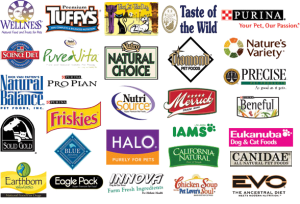Originally published November 29th, 2015
 There is a bewildering array of pet food brands, and products within brands, out there to choose from. Products ranging from dry kibble, to canned, to fresh-frozen, to raw meat are available. All have some benefit, all have some risk. How do you decide which of these are best for your lifestyle and your pet’s health? Here are some tips to help you wend your way through the brand maze and select the best products to consider.
There is a bewildering array of pet food brands, and products within brands, out there to choose from. Products ranging from dry kibble, to canned, to fresh-frozen, to raw meat are available. All have some benefit, all have some risk. How do you decide which of these are best for your lifestyle and your pet’s health? Here are some tips to help you wend your way through the brand maze and select the best products to consider.
#1: The Pet Food Company
Many pet owners don’t trust larger pet food companies, thinking that a large corporation is by nature callous and uncaring. Smaller brands are more closely linked to their customers and likely to make better, safer products. However, statistics tell a different story.
According to Drew Harwell’s article, “The McDonaldization of American Pet Food”, in the The Washington Post, February 5, 2015, three companies produce 93% of all pet foods sold in the U.S. — Big Heart, Mars, and Purina.
Yet 73 of the 88 recall events documented by the DogFoodAdvisor.com website during October 2009 through February 2015 link to products of smaller brands, not the big three. These smaller companies account for only 7% of the pet food and treats sold but generate 83% of the recalls.
Smaller companies are also less likely to spend money on regular verification of nutritional content or to have food scientists on staff. Some smaller companies don’t even own their manufacturing facilities, they hire the production out to other factories, sometimes overseas where regulations and oversight are nearly nonexistent.
Should you avoid small pet food companies? Not necessarily, but you will want to know some things about them: like how and where they manufacture the product and whether they offer proof of nutritional content. The law does not require pet food companies to actually meet the claims they make on their bags or in their advertising!
#2: The Label
Pet food labels should offer valuable information. Some are difficult to read. If it seems incomprehensible, it may be so deliberately. A company with nothing to hide will spell out its ingredients clearly and proudly.
How do you know which ingredients are good and which to avoid? Look to professional dog food reviews. Personal testimonies and customer reviews should bear little weight in your final decision. Then find brands that have a variety of products that all rate highly. A company, large or small, that can garner high ratings over their entire product line is doing things right.
Comparing labels across brands can help as well. Lower quality products will contain:
- Less real meat
- More meat by-products
- Controversial preservatives or additives
- Anonymous meat ingredients
#3: The Manufacturer
Don’t assume a pet food company actually makes the products they sell. Today, many companies use third-party co-packers to manufacture their products. Some pet food companies are little more than advertising agencies who completely farm-out the manufacturing of their products. In this case there is little if any supervision or quality control.
Some brands make their own from start to finish. Others buy ready-made foodstuffs and combine them for a finished product.
Whether a manufacturer does all, some or none of the manufacturing is not as important as knowing who DOES manufacture the brand you’re buying so you know, should their product be recalled.
#4: Nutrient Testing
You also want to know how, or if, the company is certain its product attains a proper nutritional content.
- How often is nutritional content tested?
- Does the company conduct laboratory analysis?
- Does the company run feeding trials?
Find out how a company tests each product to assure it meets AAFCO nutritional guidelines.
#5: Ingredient Sources
No food is better than the ingredients used to make it. Some purchase ingredients through commodity brokers on the open market from the cheapest source. Others come from countries known to have inferior food quality standards. Better companies source their raw materials from established, reliable, regional suppliers they do business with on an ongoing basis.
Labels generally do not disclose ingredient sources. They don’t have to. So you may have to visit a web site or make a call and ask. If they refuse to provide this information, avoid that manufacturer.
#6: Recall History
Pet food recalls provide valuable clues about a brand’s manufacturing habits. Don’t overreact to dog food recalls. Any process involving human beings will encounter an occasional error. If recalls are frequent, that is a warning sign.
Also look at how the company responded to past recalls. A company that works hard to quickly rectify a problem is worth considering. One that works equally hard to cover it up is not worth considering. For example, some brands have conducted silent recalls: informing only their distributors about a problem, not the public.
SUMMARY
Knowing what to look for as good ingredients, bad ingredients, manufacturing processes, ingredient origins, and nutritional assurances will help you find a reliable pet food brand. When you find a product that meets these guidelines, you can feel confident you’ve found a superior pet food brand.
| If you enjoy our updates, Doggy Tales, and educational articles consider subscribing for notices when new pieces are posted. It’s painless and you can unsubscribe any time you want. Your e-mail address is used ONLY to deliver these notices. | [email-subscribers namefield=”YES” desc=”” group=”Public”] |



